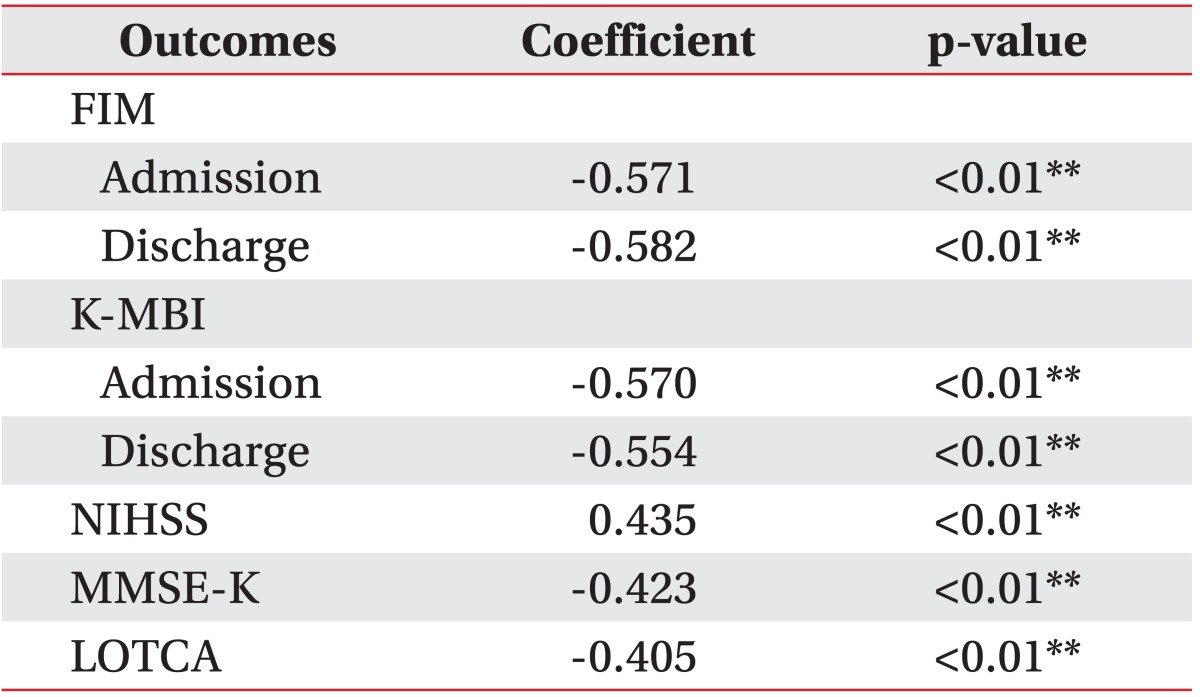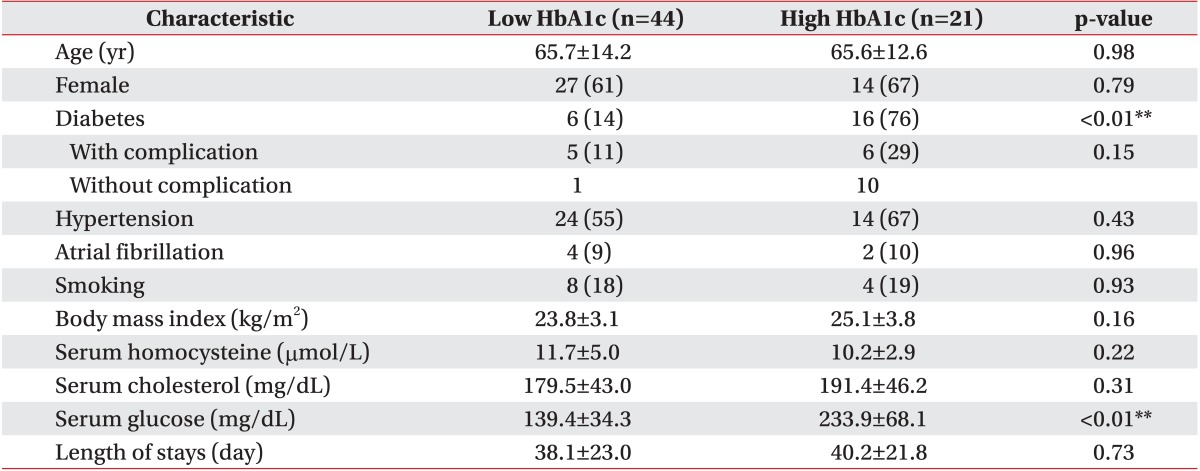1. Wolfe CD. The impact of stroke. Br Med Bull 2000;56:275-286. PMID:
11092079.



2. Adams HP Jr, Davis PH, Leira EC, Chang KC, Bendixen BH, Clarke WR, et al. Baseline NIH Stroke Scale score strongly predicts outcome after stroke: a report of the Trial of Org 10172 in Acute Stroke Treatment (TOAST). Neurology 1999;53:126-131. PMID:
10408548.


3. Frankel MR, Morgenstern LB, Kwiatkowski T, Lu M, Tilley BC, Broderick JP, et al. Predicting prognosis after stroke: a placebo group analysis from the National Institute of Neurological Disorders and Stroke rt-PA Stroke Trial. Neurology 2000;55:952-959. PMID:
11061250.


4. Muir KW, Weir CJ, Murray GD, Povey C, Lees KR. Comparison of neurological scales and scoring systems for acute stroke prognosis. Stroke 1996;27:1817-1820. PMID:
8841337.


5. Andersen KK, Andersen ZJ, Olsen TS. Predictors of early and late case-fatality in a nationwide Danish study of 26,818 patients with first-ever ischemic stroke. Stroke 2011;42:2806-2812. PMID:
21817152.


6. Knoflach M, Matosevic B, Rucker M, Furtner M, Mair A, Wille G, et al. Functional recovery after ischemic stroke: a matter of age: data from the Austrian Stroke Unit Registry. Neurology 2012;78:279-285. PMID:
22238419.


7. Petty GW, Brown RD Jr, Whisnant JP, Sicks JD, O'Fallon WM, Wiebers DO. Ischemic stroke subtypes : a population-based study of functional outcome, survival, and recurrence. Stroke 2000;31:1062-1068. PMID:
10797166.


8. Nedeltchev K, der Maur TA, Georgiadis D, Arnold M, Caso V, Mattle HP, et al. Ischaemic stroke in young adults: predictors of outcome and recurrence. J Neurol Neurosurg Psychiatry 2005;76:191-195. PMID:
15654030.



9. Sumer MM, Ozdemir I, Tascilar N. Predictors of outcome after acute ischemic stroke. Acta Neurol Scand 2003;107:276-280. PMID:
12675701.


10. Saposnik G, Raptis S, Kapral MK, Liu Y, Tu JV, Mamdani M, et al. The iScore predicts poor functional outcomes early after hospitalization for an acute ischemic stroke. Stroke 2011;42:3421-3428. PMID:
21960583.


11. Shindo A, Tomimoto H. Diabetes and ischemic stroke. Brain Nerve 2014;66:107-119. PMID:
24523309.

12. Cantu-Brito C, Mimenza-Alvarado A, Sanchez-Hernandez JJ. Diabetes mellitus and aging as a risk factor for cerebral vascular disease: epidemiology, pathophysiology and prevention. Rev Invest Clin 2010;62:333-342. PMID:
21222313.

13. Mankovsky BN, Ziegler D. Stroke in patients with diabetes mellitus. Diabetes Metab Res Rev 2004;20:268-287. PMID:
15250030.


14. Luitse MJ, Biessels GJ, Rutten GE, Kappelle LJ. Diabetes, hyperglycaemia, and acute ischaemic stroke. Lancet Neurol 2012;11:261-271. PMID:
22341034.


15. Kruyt ND, Biessels GJ, Devries JH, Roos YB. Hyperglycemia in acute ischemic stroke: pathophysiology and clinical management. Nat Rev Neurol 2010;6:145-155. PMID:
20157308.



16. Kamouchi M, Matsuki T, Hata J, Kuwashiro T, Ago T, Sambongi Y, et al. Prestroke glycemic control is associated with the functional outcome in acute ischemic stroke: the Fukuoka Stroke Registry. Stroke 2011;42:2788-2794. PMID:
21817134.


17. Saudek CD, Derr RL, Kalyani RR. Assessing glycemia in diabetes using self-monitoring blood glucose and hemoglobin A1c. JAMA 2006;295:1688-1697. PMID:
16609091.


18. American Diabetes Association. Standards of medical care in diabetes, 2014. Diabetes Care 2014;37(Suppl 1): S14-S80. PMID:
24357209.


19. Rohlfing CL, Wiedmeyer HM, Little RR, England JD, Tennill A, Goldstein DE. Defining the relationship between plasma glucose and HbA(1c): analysis of glucose profiles and HbA(1c) in the Diabetes Control and Complications Trial. Diabetes Care 2002;25:275-278. PMID:
11815495.


20. Zoungas S, Chalmers J, Ninomiya T, Li Q, Cooper ME, Colagiuri S, et al. Association of HbA1c levels with vascular complications and death in patients with type 2 diabetes: evidence of glycaemic thresholds. Diabetologia 2012;55:636-643. PMID:
22186981.


21. Caplan LR, Van Gijn J. Stroke syndromes. 3rd ed. New York: Cambridge University press; 2012. p.344-358.
22. Caplan LR. Diabetes and brain ischemia. Diabetes 1996;45(Suppl 3): S95-S97. PMID:
8674904.


23. Ghika J, Bogousslavsky J, Regli F. Infarcts in the territory of lenticulostriate branches from the middle cerebral artery. Etiological factors and clinical features in 65 cases. Schweiz Arch Neurol Psychiatr 1991;142:5-18.

24. Hjalmarsson C, Manhem K, Bokemark L, Andersson B. The role of prestrike glycemic control on severity and outcome of acute ischemic stroke. Stroke Res Treat 2014;2014:694569PMID:
25295219.


25. Wu S, Wang C, Jia Q, Liu G, Hoff K, Wang X, et al. HbA1c is associated with increased all-cause mortality in the first year after acute ischemic stroke. Neurol Res 2014;36:444-452. PMID:
24649851.


26. Lei C, Wu B, Liu M, Chen Y. Association between hemoglobin A
1C levels and clinical outcome in ischemic stroke patients with or without diabetes. J Clin Neurosci 2015;22:498-503. PMID:
25595961.


27. Baird TA, Parsons MW, Phan T, Butcher KS, Desmond PM, Tress BM, et al. Persistent poststroke hyperglycemia is independently associated with infarct expansion and worse clinical outcome. Stroke 2003;34:2208-2214. PMID:
12893952.


28. Garg R, Chaudhuri A, Munschauer F, Dandona P. Hyperglycemia, insulin, and acute ischemic stroke: a mechanistic justification for a trial of insulin infusion therapy. Stroke 2006;37:267-273. PMID:
16306459.


29. Williams LS, Rotich J, Qi R, Fineberg N, Espay A, Bruno A, et al. Effects of admission hyperglycemia on mortality and costs in acute ischemic stroke. Neurology 2002;59:67-71. PMID:
12105309.


30. Weil ZM. Ischemia-induced hyperglycemia: consequences, neuroendocrine regulation, and a role for RAGE. Horm Behav 2012;62:280-285. PMID:
22521211.


31. Chmielewska B, Hasiec T, Belniak-Legiec E. Value of glucose, glycosylated hemoglobin and fructosamine in blood of patients with ischemic cerebral infarction without diabetes during the early stage of the disease. Ann Univ Mariae Curie Sklodowska Med 1996;51:61-68. PMID:
9467249.

32. Allport LE, Butcher KS, Baird TA, MacGregor L, Desmond PM, Tress BM, et al. Insular cortical ischemia is independently associated with acute stress hyperglycemia. Stroke 2004;35:1886-1891. PMID:
15192241.


33. Capes SE, Hunt D, Malmberg K, Pathak P, Gerstein HC. Stress hyperglycemia and prognosis of stroke in nondiabetic and diabetic patients: a systematic overview. Stroke 2001;32:2426-2432. PMID:
11588337.


34. Ogbera AO, Oshinaike OO, Dada O, Brodie-Mends A, Ekpebegh C. Glucose and lipid assessment in patients with acute stroke. Int Arch Med 2014;7:45PMID:
25379056.



35. Murros K, Fogelholm R, Kettunen S, Vuorela AL, Valve J. Blood glucose, glycosylated haemoglobin, and outcome of ischemic brain infarction. J Neurol Sci 1992;111:59-64. PMID:
1402998.













